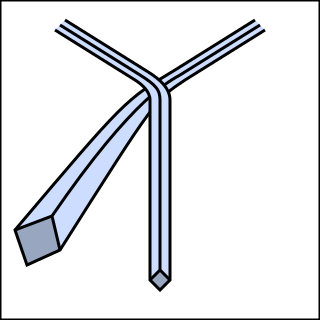 W
WThe 85 Ways to Tie a Tie is a book by Thomas Fink and Yong Mao about the history of the knotted neckcloth, the modern necktie, and how to tie both. It is based on two mathematics papers published by the authors in Nature and Physica A while they were research fellows at Cambridge University’s Cavendish Laboratory. The authors prove that, assuming both the tie and the wearer to be of typical size, there are exactly 85 ways of tying a necktie using the conventional method of wrapping the wide end of the tie around the narrow end. They describe each and highlight those that they determine to be historically notable or aesthetically pleasing.
 W
WThe four-in-hand knot is a method of tying a necktie. It is also known as a simple knot or schoolboy knot, due to its simplicity and style. Some reports state that carriage drivers tied their reins with a four-in-hand knot, while others claim that the carriage drivers wore their scarves in the manner of a four-in-hand, but the most likely etymology is that members of the Four-in-Hand Club in London began to wear the neckwear, making it fashionable. The knot produced by this method is on the narrow side, notably asymmetric, and appropriate for most, but not all occasions. For United States Army uniforms, and United States Navy uniforms that include a necktie, the four-in-hand knot is one of three prescribed options for tying the necktie, the other two being the half-Windsor and Windsor.
 W
WThe Grantchester knot is a self-releasing, asymmetric way of tying a necktie. Using the notation presented in The 85 Ways to Tie a Tie, it is a Lo Ri Lo Ri Co Li, finishing with Ro Li Co T.
 W
WThe half-Windsor knot, also known as the single Windsor knot, is a way of tying a necktie which produces a neat, triangular knot. It is larger than the four-in-hand knot and Pratt knot, but smaller than the Windsor knot. The half-Windsor is derived from the Windsor in that it is only brought up around the loop on one side rather than both. It works well with light- and medium-weight fabrics.
 W
WThe Pratt knot is a method of tying a necktie. It is also known as the Shelby knot and the Pratt-Shelby. The knot was created by Jerry Pratt, an employee of the US Chamber of Commerce in the late 1950s. It was popularized as the Shelby knot after then 92-year-old Pratt taught it in 1986 to television reporter Don Shelby who he felt had been tying his tie poorly on the air. Shelby then refined the Pratt knot with local clothier Kingford Bavender and wore it on the air with a spread collar where it stood out and attracted attention for its symmetry and trim precision.
 W
WThe small knot, or oriental knot or Kent knot or simple knot, is the simplest method of tying a necktie, though some claim the simple knot is an alternative name for the four-in-hand knot. The small knot is not very well known despite its simplicity. One of the reasons may be that the small knot is not self-releasing, and may annoy people accustomed to four-in-hand and Windsor knots who pull at the tie to untangle the knot. Additionally, it is a common opinion that, should the thin end of the tie become visible, it not be "inside out"; the small knot is one of several that violate this preference, though this can be remedied by giving the entire tie a half-twist during the tying process.
 W
WThe Windsor knot, sometimes referred to as a full Windsor to distinguish it from the half-Windsor, is a knot used to tie a necktie. As with other common necktie knots, the Windsor knot is triangular, and the wide end of the tie drapes in front of the narrow end. The Windsor is a wider knot than most common knots, and while not truly symmetric is more balanced than the common four-in-hand knot. The Windsor's width makes it especially suited to be used in conjunction with a spread or cutaway collar.